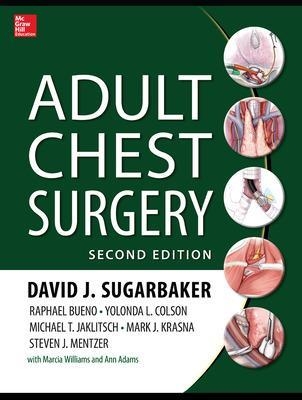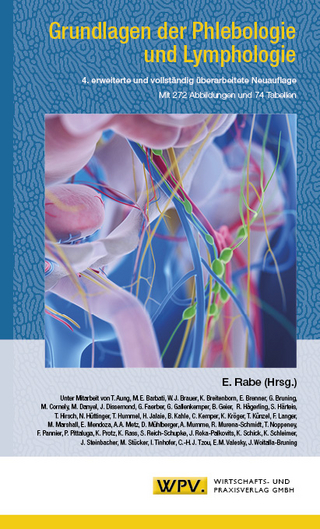
Adult Chest Surgery
McGraw-Hill Professional (Verlag)
978-0-07-178189-3 (ISBN)
- Titel ist leider vergriffen;
keine Neuauflage - Artikel merken
Publisher's Note: Products purchased from Third Party sellers are not guaranteed by the publisher for quality, authenticity, or access to any online entitlements included with the product.
The most authoritative, comprehensive, and clinicallyfocused guide to operative thoracic surgery--updatedwith the latest techniques and technologiesA Doody's Core Title for 2019!
Adult Chest Surgery is a thorough, hands-on guide to the modern practice of general thoracic surgery. Broad in scope and straightforward in style and presentation, this classic is an outstanding reference for any clinician in need of a comprehensive description ofthe clinical nature of general thoracic surgery.
Like its award-winning predecessor, the second edition of Adult Chest Surgery focuses on providing concise descriptions of current techniques and surgical principles for the most common thoracic surgical problems encountered in the clinic and the operating room. This edition is enhanced by 40 new chapters devoted to a range of topics including new endoscopic techniques for antireflux surgery; percutaneous thoracic tumor ablation; peroral esophageal myotomy; robotic techniques for lobectomy, esophagectomy, and thymectomy; and other new minimally invasive approaches to standard thoracic resections. It is also enriched by more than 250 new detailed illustrations of procedures, bringing the total number to 850.
Adult Chest Surgery features a logical organization based on anatomy, and each section has an overview chapter, which summarizes the relevant anatomy, pathophysiology, and diagnostic and procedural options. Throughout, operations and diagnostic procedures are highlighted in succinct, illustrated technique chapters.
David J. Sugarbaker, MD (Houston, TX) is Director of the The Lung Institute, Professor of Surgery, Baylor College of Medicine
Part 1: Care and Management of the Thoracic Surgery Patient
Chapter 1: Introduction
Chapter 2: Thoracic Incisions
Chapter 3: Chest Imaging: Role of CT, PET/CT, and MRI
Chapter 4: Preoperative Evaluation
Chapter 5: Anesthesia Management
Chapter 6: Critical Care
Chapter 7: Mechanical Ventilation
Chapter 8: Postoperative Management
Chapter 9. Role of the Pathologist
Part 2: Esophageal and Proximal Stomach Malignancy
Chapter 10:Overview
Chapter 11: Surgical Approach to Gastroesophageal Junction Cancers
Chapter 12: Esophagoscopy
Chapter 13: Minimally Invasive Esophagectomy
Chapter 14: Transhiatal Esophagectomy
Chapter 15: Three-Hole Esophagectomy: The Brigham and Women's Hospital Approach
Chapter 16: Ivor Lewis Esophagectomy
Chapter 17: Radical En Bloc Esophagectomy
Chapter 18: Three-Field Esophagectomy
Chapter 19: Left Thoracoabdominal Approach
Chapter 20: Left Transthoracic Esophagectomy
Chapter 21: Options for Esophageal Replacement
Chapter 22: Palliative Options and Procedures
Chapter 23: Management of Malignant Esophageal Fistula
Part 3: Esophageal Motility Disorders
Chapter 24: Overview
Chapter 25: Resection of Esophageal Diverticula
Chapter 26: Esophagocardiomyotomy for Achalasia
Chapter 27: Long Esophageal Myotomy
Chapter 28: Esophagectomy
Part 4: Esophageal Reflux Disorders
Chapter 29: Overview
Chapter 30: Belsey-Mark IV Fundoplication/Collis Gastroplasty
Chapter 31: Nissen Fundoplication
Chapter 32: Other Reflux Procedures
Chapter 33: Surgery for Barrett’s Esophagus
Chapter 34: Management of Shortened Esophagus
Chapter 35: Management of the Failed Reflux Operation
Chapter 36: Techniques for Dilatation of Benign Esophageal Stricture
Part 5: Benign Congenital and Traumatic Esophageal Disorders
Chapter 37: Overview
Chapter 38: Congenital Disorders of the Esophagus in Infants and Children
Chapter 39: Resection of Benign Tumors of the Esophagus
Chapter 40: Management of Esophageal Perforation
Chapter 41: Blunt and Penetrating Esophageal Trauma
Chapter 42: Surgical Management of Corrosive Injury to the Esophagus
Chapter 43: Techniques and Indications for Esophageal Exclusion
Part 6: Benign Disorders of the Upper Airways
Chapter 44: Overview
Chapter 45: Tracheostomy
Chapter 46: Endoscopic Treatments
Chapter 47: Use of Tracheobronchial Stents
Chapter 48: Techniques of Tracheal Resection and Reconstruction
Chapter 49: Surgical Repair of Congenital and Acquired Tracheoesophageal Fistulas
Chapter 50: Tracheobronchial Injuries
Part 7: Cancer of the Upper Airways
Chapter 51: Overview
Chapter 52: Bronchoscopy
Chapter 53: Management of Sputum-Positive Lung Cancer
Chapter 54: Techniques of Tracheal Resection
Chapter 55: Subglottic Resection of the Airway
Chapter 56: Resection of the Carina
Chapter 57: Mediastinal Tracheostomy
Chapter 58: Tumors of the Upper Aerodigestive Tract: Cervical Exenteration
Chapter 59: Ablative Endoscopic Therapy for Endobronchial Lesions
Part 8: Lung Cancer
Chapter 60: Overview
Chapter 61: Mediastinoscopy and Restaging
Chapter 62: The Five Lobectomies
Chapter 63: VATS Lobectomy
Chapter 64: Pneumonectomy
Chapter 65: Segmentectomy
Chapter 66: Sleeve Resection/Bronchoplasty for Lung Cancer
Chapter 67: Pancoast’s Syndrome: Extended Resection in the Superior Pulmonary Sulcus
Chapter 68: Pancoast’s Syndrome: Anterior Approach to Pancoast Tumor
Chapter 69: Radical Lymphadenectomy
Chapter 70: Cardiopulmonary Bypass for Extended Thoracic Resections
Chapter 71: Pulmonary Metastasectomy
Chapter 72: Surgical Treatment of Bronchopleural Fistula after Pneumonectomy
Chapter 73: Management of Hemoptysis in Lung Cancer
Chapter 74: Adjuvant and Neoadjuvant Radiotherapy in NSCLC
Chapter 75: Innovative Radiation Techniques: Role of Brachytherapy and Intraoperative Radiotherapy in Treatment of Lung Cancer
Chapter 76: Adjuvant Chemotherapy for Surgically Resected Non-Small Cell Lung Cancer
Chapter 77: Percutaneous Thoracic Tumor Ablation
Chapter 78: Resection of Bronchogenic Carcinoma with Solitary Brain Metastasis
Part 9: Benign Tumors and Conditions of the Lung
Chapter 79: Overview
Chapter 80: Benign Lung Masses
Chapter 81: Bronchoplasty
Chapter 82: Pulmonary Sequestration
Chapter 83: Surgery for Bronchiectasis
Chapter 84: Pulmonary Arteriovenous Malformation
Part 10: Chronic Obstructive Pulmonary Disease
Chapter 85: Overview
Chapter 86: Resection of Blebs, Bullae, and Giant Bullae
Chapter 87: Lung Volume-Reduction Surgery
Chapter 88: Minimally Invasive Methods of Managing the Bullae in Compromised Patients
Chapter 89: New Endoscopic Approaches for Treatment of Emphysema
Part 11: Lung Infections and Interstitial Lung Disease
Chapter 90: Thoracic Fungal Infections
Chapter 91: Role of the Thoracic Surgeon in the Diagnosis of Interstitial Lung Disease
Chapter 92: Thoracoplasty for Tuberculosis
Chapter 93: Surgical Approaches for Chronic Empyema and for Management of Chronic Bronchopleural Fistula
Part 12: Lung Transplantation
Chapter 94: Overview
Chapter 95: Lung Transplantation Technique
Chapter 96: Living Lobar Lung Transplantation
Chapter 97: Medical Management Of Lung Transplant Patients
Chapter 98: Management Of Surgical Complications
Part 13: Diffuse Pleural Malignancies and Effusions
Chapter 99: Overview
Chapter 100: Nonoperative Treatment of Malignant Pleural Effusions
Chapter 101: Thoracoscopy with Interpleural Sclerosis for Malignant Pleural Effusion
Chapter 102: Pleurectomy and Decortication for Malignant Pleural Diseases
Chapter 103: Extrapleural Pneumonectomy for Diffuse Malignant Pleural Mesothelioma and Other Diffuse Pleural Malignancies
Chapter 104: Intracavitary Hyperthermic Chemotherapy for Malignant Pleural Mesothelioma
Chapter 105: Photodynamic Therapy in the Management of Malignant Pleural Effusions
Part 14: Benign Pleural Conditions
Chapter 106: Overview
Chapter 107: Medical Management of Nonmalignant Pleural Effusions
Chapter 108: Pneumothorax and Pneumomediastinum
Chapter 109: Benign Tumors of the Pleura
Chapter 110: Management of Acute Bronchopleural Fistula
Chapter 111: Nonoperative Therapy for Chylothorax
Chapter 112: Fibrothorax and Decortication
Chapter 113: Management of Chylothorax
Part 15: Chest Wall and Sternal Tumors
Chapter 114: Overview
Chapter 115: Chest Wall Resection And Reconstruction
Chapter 116: Sternal and Clavicular Chest Wall Resection and Reconstruction
Chapter 117: Options for Plastic Chest Wall Reconstruction
Part 16: Benign Disorders of the Chest Wall
Chapter 118: Overview
Chapter 119: Primary Repair of Chest Wall Defects
Chapter 120: Surgical Repair of Complex (Recurrent) Pectus Excavatum in Adults
Chapter 121: Thoracoscopic Sympathicotomy for Hyperhidrosis and Vasomotor Disorders
Chapter 122: Supraclavicular Approach for Thoracic Outlet Syndrome
Chapter 123: Thoracic Outlet Syndromes
Chapter 124: Thorascopic First-Rib Resection with Dorsal Sympathectomy
Chapter 125: Thrombosis of the Subclavian Vein: Paget-Schroetter Syndrome
Chapter 126: Surgical Treatment for Chest Wall Infections
Part 17: Diaphragmatic Diseases, Benign or Malignant
Chapter 127: Overview
Chapter 128: Diaphragm Incisions
Chapter 129: Surgical Plication of the Diaphragm for Paralysis and Eventration
Chapter 130: Techniques for Repair of Paraesophageal Hiatal Hernia
Part 18: Mediastinal Diseases, Benign Or Malignant
Chapter 131: Overview
Chapter 132: Cervical Mediastinoscopy and Anterior Mediastinotomy
Chapter 133: Resection of Substernal Goiter
Chapter 135: Thoracoscopic Approach to Thymectomy with Advice on Patients with Myasthenia Gravis
Chapter 136: Radical Transsternal Thymectomy
Chapter 137: Resection of Benign Anterior and Middle Mediastinal Cysts and Tumors
Chapter 138: Neurogenic Tumors of the Posterior Mediastinum
Chapter 139: Malignant Primary Anterior Mediastinal Tumors
Chapter 140: Resection for Superior Vena Cava Syndrome
Part 19: Robotics
Chapter 141: Robotics in Thoracic Surgery
| Zusatzinfo | 400 Illustrations, unspecified |
|---|---|
| Sprache | englisch |
| Maße | 221 x 279 mm |
| Gewicht | 3311 g |
| Themenwelt | Medizinische Fachgebiete ► Chirurgie ► Herz- / Thorax- / Gefäßchirurgie |
| ISBN-10 | 0-07-178189-7 / 0071781897 |
| ISBN-13 | 978-0-07-178189-3 / 9780071781893 |
| Zustand | Neuware |
| Haben Sie eine Frage zum Produkt? |
aus dem Bereich


